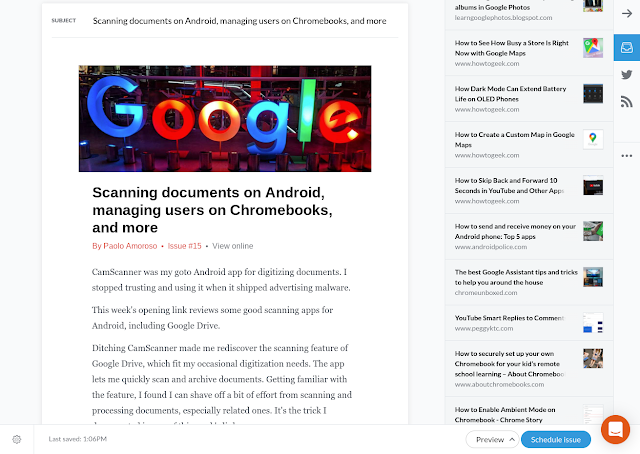My Newsletter Publishing Process
It’s been almost four months since I launched Practicing Google, my weekly newsletter about practical resources on Google products and related technologies.
The newsletter is a spinoff of my efforts to learn about and keep up to date with the Google ecosystem. I share links from my readings and content consumption habits. I wanted to focus on the entire Google ecosystem with a practical angle, an empty niche I thought there would be interest in.
As a byproduct of activities I already do, I hoped producing the newsletter wouldn’t take much work, and I’d be able to keep the overhead low. This proved to be the case, thanks to a combination of tools and workflow.
Here is how I produce, edit, test, and publish each issue of the newsletter
Tools
I use the Revue newsletter publishing platform. My primary production tool is Revue’s issue editor that allows to add rich text, links, media, and embeds.
Revue also provides tools for integrating with and importing content from social networks and publishing platforms like Twitter, Medium, and more. Although different, the tools all work as web clippers. They let me save a link with a thumbnail and snippet and make it accessible within Revue’s issue editor. Thus I can drag the saved links from a sidebar at the right of the editor and drop them into the text of a draft issue.
The web clipper I use is the Revue Chrome extension. By clicking an icon in the browser, I can save to the editor the link of the current web page.
To help edit the text of an issue I use ProWritingAid. It’s a grammar checker, style editor, and writing mentor. It provides a wealth of reports and tools to find grammar and style issues and suggest improvements. ProWritingAid is an invaluable resource for a non-native English speaker like me who writes a lot of English text.
Mail-Tester is a newsletter checking service which examines and scores an issue based on signals ranging from spammyness to technical compliance with good email standards. I use Mail-Tester to validate an issue before publishing it.
Workflow
The production of the next issue starts in the browser when I read online content for information or learning. If a blog post, a tutorial, or another resource seems a suitable match for Practicing Google, I save it to Revue with the web clipper. Not all the content I read ends up in the newsletter, but I conservatively save everything potentially relevant.
I send out the current issue on Friday. A day or so earlier, on Thursday or Friday, in Revue I duplicate a recent issue as a template for the next draft issue. I edit it to remove the old content and make room for new items.
At this point it’s time to browse the right sidebar listing the links saved with the web clipper. I drop some links into the draft issue and rearrange things a bit. This is not enough to fill all the content slots. I browse other sources, such as my bookmarks and Google Play wishlist, looking for Android or web apps to feature.
The next step is to write the introduction of the issue. You can think of it as yours truly’s op-ed.
I continue by writing the headings and descriptions of the links. Each issue has five practical resources, plus an Android app, and a web app or cloud tool. I usually write this text in one sitting. Since the first weeks of the newsletter, I developed a sensibility for what mix of links makes for a varied and interesting issue.
Over the weekend I revise, tweak, and polish the text. On rare occasions, I realize a link is out of place and replace it with something better.
By the beginning of the following week, I’ve re-read the draft issue several times. The text is solid enough, so I usually change only a few words or short phrases.
Wednesday is the last editing day. I run the text through ProWritingAid for a last revision. Then I no longer touch the issue’s text unless something turns out to be incorrect, I find interesting stuff to add, or something just feels off.
On Thursday the issue is ready, but it needs a few more checks.
I inspect the web preview of the draft issue and send a copy to my Gmail address for testing. I examine the email preview from my Chromebox and in the Gmail app on my Pixel 2 XL phone.
I send another email preview to Mail-Tester. If the score is good, the issue is ready for the last step: scheduling for publication. Back in Revue, I schedule sending the issue to subscribers by email on Friday. The scheduling dialog lets me also edit a tweet to post automatically.
Next, it’s up to you, the reader, to open the new issue and hopefully enjoy it.



